Eastern Germany (inc. Berlin) 2024
(Page 6 of 7 / Links to other pages at end of this page)
Day 6 – Potsdam and Nietzsche-Haus, Naumburg
Day 6 included an early start, leaving the accommodation in Berlin and taking the U-Bahn and an overground train back to Berlin Brandenburg Airport to pick up another hire car (two separate car hires worked out cheaper for this trip, bearing in mind one wasn’t needed for the day in Berlin). We then drove to Potsdam for a look around Cecilienhof (one of the many palaces in Potsdam but od historical importance), stopping off at the Glienicke Bridge (“Bridge of Spies”) on the way. After Potsdam, we drove to the town of Naumburg to visit the Nietzsche-Haus (a former family home and now museum dedicated to the life and work of the German philosopher Friedrich Nietzsche), followed by a stop at Röcken Churchyard, Lützen, to see Nietzsche’s grave. From here, we then headed off to our accommodation for our final night (details below).

Above: A temporary exhibit in the reception hall of Terminal 1, Berlin Brandenburg Airport, the United Buddy Bears THE MINIS stand for freedom, international understanding and peaceful coexistence. Each bear represents a country in the world and is “individually designed to celebrate the diversity and creativity of our global community”. More information Here (external link).
Glienicke Bridge
The Glienicke Bridge, also known as the “Bridge of Spies,” spans the Havel River, connecting the Wannsee district of Berlin with Potsdam. This bridge gained historical significance during the Cold War as the site of several high-profile exchanges of captured spies between the Eastern Bloc and the West. One of the most notable exchanges occurred in 1985, involving 23 American agents and four Soviet agents. The bridge’s unique role in espionage history makes it a fascinating landmark to visit.
 |
 |
|
 |
 |
The bridge has been featured on a number of occasions in popular culture, including the 1966 Harry Palmer film, Funeral in Berlin, based on the novel of the same name, the multiple Oscar-winning 2015 film Bridge of Spies, directed by Steven Spielberg and starring Tom Hanks (features the Powers–Abel prisoner exchange on the bridge as a major plot element), and the same name was used by the British band T'Pau as the name of the title track on their first album.
Potsdam
Potsdam, the capital of Brandenburg, is renowned for its stunning palaces, gardens, and historical significance. Its rich history includes once being the imperial capital of the Prussian kings and home to many royal residences, a centre of immigration, and a site of the Potsdam Agreement. Key attractions include the Sanssouci Palace (often referred to as the “Prussian Versailles” this rococo palace was the summer residence of Frederick the Great), New Palace (located in Sanssouci Park), the Dutch Quarter neighbourhood with its red-brick buildings and quaint streets, and Babelsberg Park (a picturesque park with a neo-Gothic palace, offering stunning views of the Havel River and the city), and Cecilienhof Palace (visited on this trip for reasons of historical interest and time constraints).
Cecilienhof Palace: A Historic Landmark in Potsdam
Cecilienhof Palace, located in the picturesque New Garden in Potsdam, is a site of immense historical significance. Built in the early 20th century, this palace is best known for hosting the Potsdam Conference at the end of World War II. Today, it stands as a testament to the pivotal moments in history that shaped the modern world.

A Brief History of Cecilienhof Palace
Cecilienhof Palace was constructed between 1913 and 1917 for Crown Prince Wilhelm and his wife, Cecilie of Mecklenburg-Schwerin. Designed in the style of an English Tudor manor, the palace features half-timbered walls, gabled roofs, and charming courtyards. It was the last palace built by the Hohenzollern dynasty.

The most significant event in Cecilienhof’s history occurred in the summer of 1945, when it hosted the Potsdam Conference. Leaders of the Allied powers – Winston Churchill (later Clement Attlee), Harry S. Truman, and Joseph Stalin – met here to negotiate the terms for the end of World War II and to shape the post-war order. The decisions made at Cecilienhof had far-reaching consequences for Germany and the rest of Europe. Some of the main sights seen here follow.
The Palace
Visitors to Cecilienhof can explore the rooms where the Potsdam Conference took place. These rooms have been preserved to reflect their appearance during the conference, providing a tangible connection to this momentous event. The conference table, chairs, and other furnishings are displayed as they were in 1945, offering a glimpse into the setting where history was made.

Cecilienhof Palace itself is an architectural gem. Its Tudor-style design, with its half-timbered walls and gabled roofs, stands out among the more classical and baroque structures in Potsdam. The palace’s charming courtyards and intricate details make it a delight for architecture enthusiasts.

The new interactive museum at Cecilienhof Palace enhances the visitor experience with modern technology. Guided tours are available, as is an audio tour (available in English) via an app that can be downloaded to a smartphone. The app includes other sites in Potsdam and is an extremely useful resource of information, although not so convenient if using your mobile phone to take photographs at the same time, and/or concerned about charge left on its battery!
Crown Princess Cecilie’s Cabin Room

The room shown above is Crown Princess Cecilie’s Cabin Room, which was designed to reflect her personal tastes. Although the exterior of Schloss Cecilienhof was designed in the English Tudor style, many of the private interior rooms have a nautical theme. Crown Princess Cecilie, originally a Duchess of Mecklenburg, wanted to reflect her northern German heritage within the palace. Consequently, some rooms, especially this room, were designed to resemble the interior of a ship’s cabin, complete with featured furniture securely attached to the floors and walls!
Reception Room

The Reception Room at Cecilienhof Palace (above) is a notable space where guests were welcomed during the Potsdam Conference. It features period furnishings and decorations, reflecting the early 20th-century style, whilst wooden panelling and intricate ceiling designs showcase the Tudor-style architecture of the palace. This room was used for informal meetings and gatherings among the leaders and their delegations.
Conference Room



The Conference Room (above) is the main highlight of the palace and is where the Potsdam Conference took place in 1945. This room is preserved with its original furnishings, including the large round table where Truman, Churchill, and Stalin sat.
Soviet Delegation Room

The office used by the Soviet delegation (shown above) is complete with displays on their contributions and decisions made during the conference. During the Potsdam Conference in 1945, this room was used by Joseph Stalin and his delegation. It has been preserved to reflect its state during the conference, providing a glimpse into the environment where critical decisions about the post-World War II order were made.
British Delegation Room


This room was used by the British delegation and includes period furniture and exhibits about their role in the conference. It was used by Winston Churchill during the Potsdam Conference in 1945. The room served as his office and meeting space until he was replaced by Clement Attlee following the British general election in July 1945.
American Delegation Room


The room used by the American delegation, showcases historical documents and artifacts related to their participation. It was used by President Harry S. Truman and his team during the conference. The room, like others used by the delegations, has been preserved to reflect its historical state, providing visitors with a glimpse into the environment where crucial decisions about the future of Europe and Asia were made.
Exhibition Areas

Above: On display at Cecilienhof are the three original chairs used
by the "Big Three" at the Potsdam Conference (British Prime Minister
Winston Churchill, US President Harry S. Truman, and Soviet leader Josef
Stalin), whilst posing for an iconic photograph outside the palace
(shown inset, lower-right).
[Inset image attribution: By Unknown author or not provided - U.S.
National Archives and Records Administration, Public Domain,
https://commons.wikimedia.org/w/index.php?curid=17060795]
Various exhibition areas throughout the palace provide context and detailed information about both the history of the palace and the Potsdam Conference and its significance. These exhibits include photographs, documents, and personal items from the time, offering a comprehensive view of the palace’s role in history.
 |
 |
|
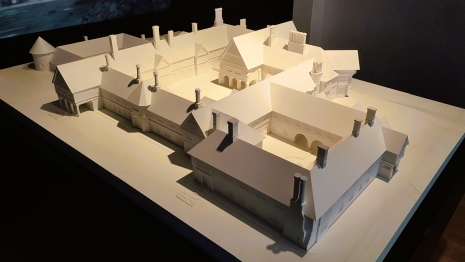 |
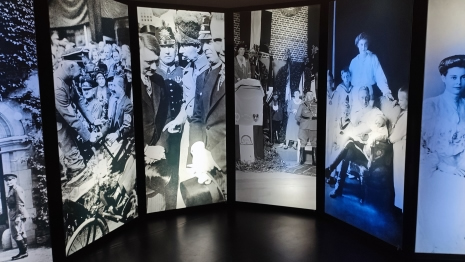 |
|
 |
 |
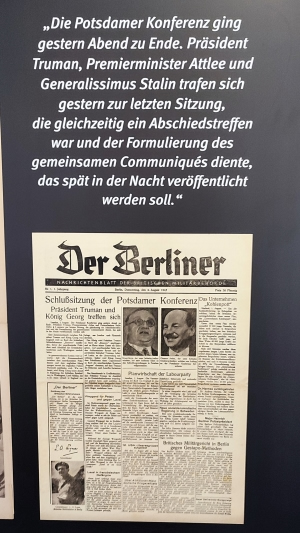 |
The Potsdam Conference was a pivotal moment in shaping the post-World War II order, and the support staff, including secretaries, were essential in facilitating the smooth operation of these high-level discussions. One of the many interesting parts of the exhibition takes a look at Joy Milward, who served as Winston Churchill’s secretary during the Potsdam Conference in 1945 (not to be confused with Joy Millward, lobbyist and suspected wife of street artist Banksy!). Joy played a significant role in assisting Churchill during this crucial period. Her work would have involved managing communications, organizing documents, and ensuring that Churchill’s needs were met during the intense negotiations. Her writings included a diary she kept from 13th to 28th July, which she recorded in an empty photo album that she found in her quarters at Kaiserstraße 6 in Babelsberg. The diary provides a very detailed insight into the 1945 conference and is on display in the exhibition:
 |
 |
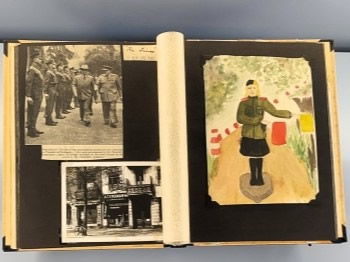 |
The Courtyard and Gardens
During the visit to the exhibition rooms, taking a look at the palace’s iconic courtyard is a must – of note here is a Soviet red star planted in the flower bed. It also gives a chance to look at more of the building’s Tudor-style architecture. After exiting the palace, if possible, a great way to end the visit at Cecilienhof is to take a stroll through the beautifully maintained gardens. The New Garden, where the palace is located, is a stunning example of landscape architecture. Designed in the English style, the garden features expansive lawns, picturesque lakes, and a variety of trees and plants.
 |
 |
|
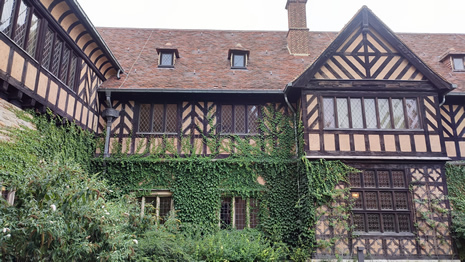 |
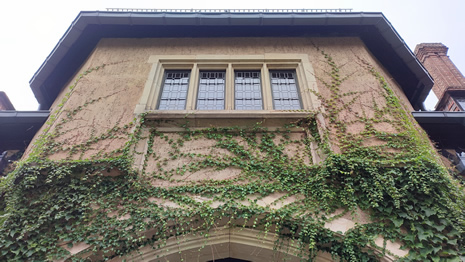 |
|
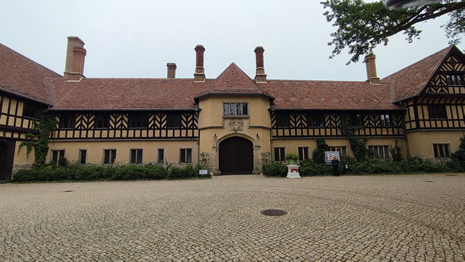 |
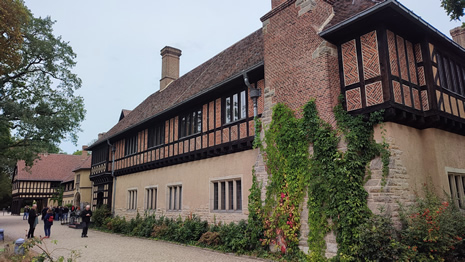 |
|
 |
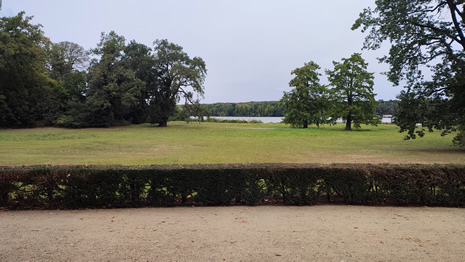 |
|
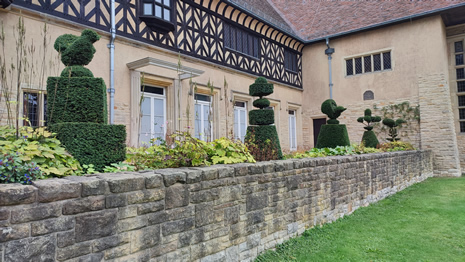 |
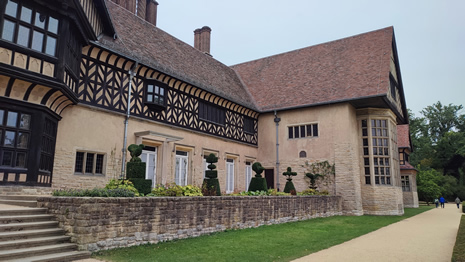 |
Muschelgrotte (Shell Grotto)
Located in the New Garden near the palace, the Muschelgrotte (Shell Grotto) is a fascinating historical site. Also referred to as Grotte am Jungfernsee (referring to the name of the nearby lake), it was built between 1791 and 1794 as a retreat for King Frederick William II of Prussia.
 |
 |
The grotto is adorned with shells and crystals, creating a unique and picturesque interior. It fell into disrepair over the years, especially during the period when it was located on the border strip of the Berlin Wall. However, restoration efforts have been ongoing since German reunification, and the grotto has been gradually restored to its former glory.
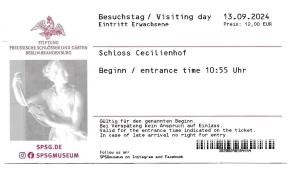
In conclusion, Cecilienhof Palace is a must-visit destination for history enthusiasts and anyone interested in the events that shaped the 20th century. From its role in the Potsdam Conference to its beautiful architecture and gardens, Cecilienhof offers a rich and immersive experience. Whether you’re exploring the interactive museum, taking a guided tour, or simply enjoying the tranquil surroundings, a visit to Cecilienhof Palace promises to be both educational and inspiring.
Nietzsche-Haus, Naumburg
Few authors have influenced 20th-century philosophy as much as Friedrich Nietzsche (1844-1900) did. The Nietzsche-Haus in Naumburg is a museum dedicated to the life and work of the philosopher Friedrich Nietzsche. Located at 18 Weingarten, this house was where Nietzsche lived with his family from 1858.

Nietzsche spent most of his childhood and youth in Naumburg. After the death of her husband, his mother, Franziska Nietzsche, moved there (in 1850) with her children, Friedrich and Elisabeth. The house was purchased by Nietzsche's mother in 1878 and remained in the family until her death in 1897. Since 1994, it has been open to the public as a museum, offering insights into Nietzsche's life and philosophy. Although all of the displays are in German, and the staff member on duty didn’t speak English, it was possible to hire audio devices to listen to commentary in English whilst walking around the numbered rooms in the house.

The museum displays personal items belonging to Nietzsche and his family, including furniture, photographs, and letters. These artifacts offer a glimpse into his daily life and personal relationships, although don’t expect a fully furnished property – perhaps it was the fact that we had just come from the lavish interiors of Cecilienhof maybe we were expecting more; the interior of the Naumburg Nietzsche-Haus is actually relatively sparse, although information posters with photographs are abound.

That said, visitors can see original manuscripts and first editions of Nietzsche's works, including some of his most famous writings like "Thus Spoke Zarathustra" and "Beyond Good and Evil”. The museum also features multimedia presentations that explore Nietzsche's philosophical ideas and their impact on modern thought. These presentations help contextualize his work within the broader history of philosophy. The Nietzsche-Haus also hosts temporary exhibitions that focus on specific aspects of Nietzsche's life or the reception of his work. These exhibitions change periodically, offering new insights and perspectives.
 |
 |
|
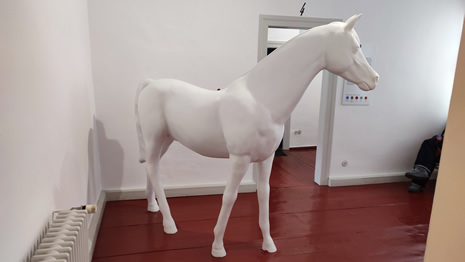 |
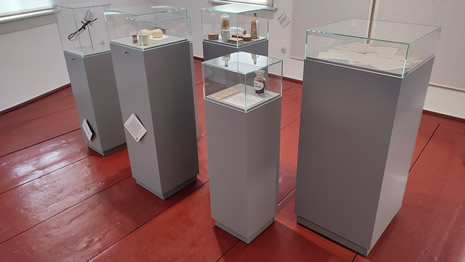 |
|
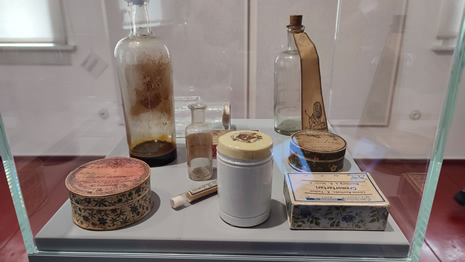 |
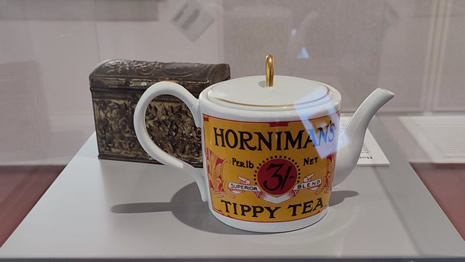 |
|
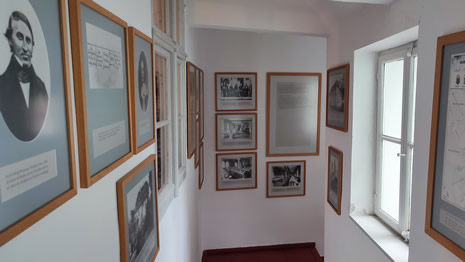 |
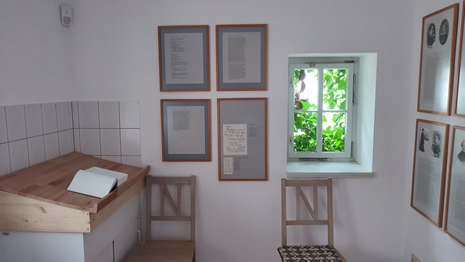 |
|
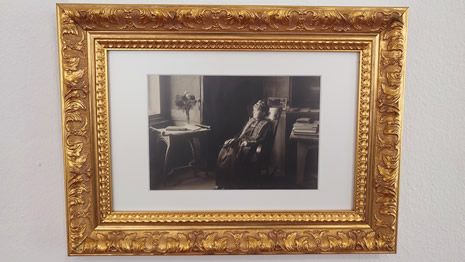 |
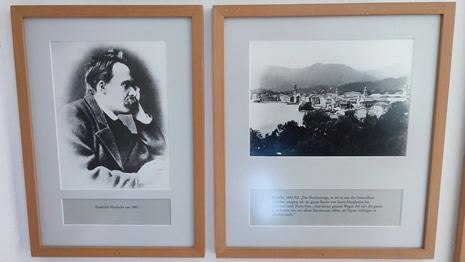 |
As well as the house, another part of the museum (not part of the audio guided tour) is the Nietzsche Documentation Centre. This part of the museum is dedicated to research and critical engagement with Nietzsche's works. It includes a library and archive that are valuable resources for scholars and enthusiasts:

Above: The Nietzsche Documentation Centre, Naumburg
As a point of note, there is also a Nietzsche-Haus museum in Sils Maria in the Engadin region of Switzerland. Interestingly also painted white with blue shutters, the house in Switzerland is where Nietzsche lived during the summers of 1881 and from 1883 to 1888.
Nietzsche's Philosophy
Philosophy is not one of the subjects this website is intended to be about and so the author won’t discuss Nietzsche’s philosophy in-depth nor hold any opinions on it – the internet, books, and so forth hold seemingly infinite amounts of information on his life and works. However, for the reader wishing to know a little about the philosophy of the man himself, a brief summary follows.
Friedrich Nietzsche's philosophy is rich and complex, touching on various themes such as morality, religion, and the nature of existence. Here are some of the key concepts:
1. Nihilism and the Death of God: Nietzsche famously declared that "God is dead", symbolizing the decline of traditional religious and moral values in the modern world. He believed this would lead to nihilism, a state where life is seen as meaningless.
2. Will to Power: This is one of Nietzsche's central ideas, suggesting that the fundamental driving force in humans is not survival or reproduction, but a will to power. This concept extends beyond mere physical power to include creativity, ambition, and self-overcoming.
3. Übermensch (Overman or Superman): Nietzsche introduced the idea of the Übermensch in "Thus Spoke Zarathustra”. The Übermensch represents an individual who has transcended the conventional values and limitations of society to create their own values and purpose.
4. Eternal Recurrence: This thought experiment asks us to imagine living our lives over and over again for eternity. Nietzsche used this idea to challenge people to live authentically and embrace their lives fully, as if they would have to relive every moment.
5. Master-Slave Morality: Nietzsche distinguished between master morality and slave morality. Master morality values pride, strength, and nobility, while slave morality values kindness, humility, and sympathy. He argued that modern society is dominated by slave morality, which he saw as a hindrance to human potential.
6. Perspectivism: Nietzsche argued that there are no absolute truths, only perspectives. This idea challenges the notion of objective reality and suggests that our understanding of the world is always influenced by our individual perspectives.
Nietzsche's work has had a profound impact on various fields, including philosophy, literature, psychology, and cultural criticism. His provocative ideas continue to inspire and challenge thinkers today.
Friedrich Nietzsche’s Grave
Our final stop, before heading off to our accommodation for the night was to see Friedrich Nietzsche’s grave. Nietzsche is buried in the graveyard at the church in Röcken, a small village just over half an hour’s drive from Naumburg. After many years of battling illness, Nietzsche passed away on August 25, 1900, in Weimar. His body was transferred to Röcken three days later and originally buried beside his father on the south side of the church in the family crypt. However, Nietzsche’s grave was moved within the same graveyard when his sister, Elisabeth Förster-Nietzsche, had his remains moved to a more prominent location within the Röcken churchyard.
 |
 |
The church in Röcken, where Nietzsche was baptized, is one of the oldest in the region, dating back to the 12th century. The burial site a place of pilgrimage for many who admire his work.
Accommodation near Colditz
Our accommodation booked online and for one night was “Pension Schützenhaus”, Leisnig (103 Chemnitzer Straße, 04703 Leisnig). We rented an apartment which had two bedrooms, a very well-equipped kitchen, and bathroom (shower) which was found to be very spacious. The accommodation is a 15-minute (8-mile/13km) drive from Colditz Castle.

Above: Pension Schützenhaus”, Leisnig. The entrance to our apartment was on the far left of the building.
Next Page (Colditz Castle and End Note to the Trip)
Previous Page (Berlin)
Introduction and Wünsdorf
Peenemünde and Polish Border on Baltic Sea
Rügen Island: Prora and Cape Arkona
Rostock
Back to Top